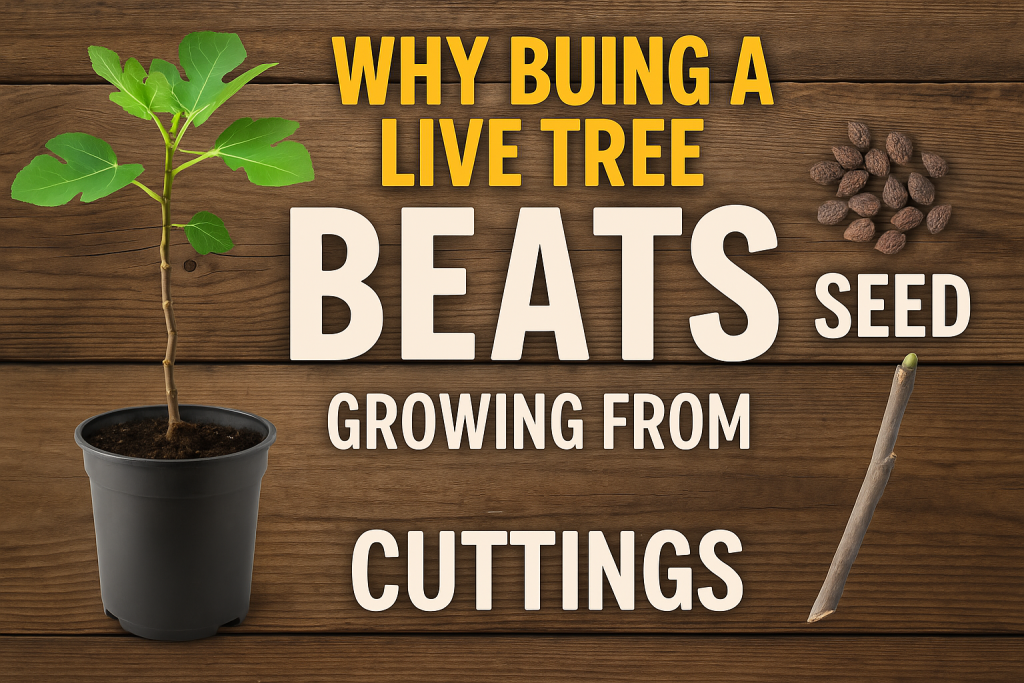Growing Figs, Learn about Figs
Why Buying a Live Tree Beats Growing from Seed or Cuttings
You ever try growing a fig tree from a seed? I have. And let me tell you—by the time that thing’s ready to fruit, you might’ve grown a beard, changed careers, and forgotten why you even started.
It’s not that starting from seed or cuttings is wrong. For some, it’s part of the charm—the long game, the experiment, the satisfaction. But for most people, especially if you’re here researching what fig to grow because you actually want figs (sooner rather than later), let’s be honest: buying a live tree is the move.
Let me explain.
The Waiting Game Isn’t for Everyone
There’s this romantic idea floating around about starting from scratch. That whole “watch it grow from nothing” thing. And yeah, there’s something beautiful about nurturing a twig into a flourishing tree—but it’s also a lesson in patience, and maybe a bit of frustration.
A fig tree grown from seed can take up to 7 years to fruit. That’s if it fruits at all—and even then, you might get a dud. No sweetness, weird texture, or a tree that needs pollination when you weren’t planning on running your own fig wasp sanctuary. Fig trees from seed don’t grow true to type. You could plant 10 seeds from a Black Madeira and not get a single fig worth eating.
Cuttings? A little better. But they come with their own baggage:
-
Not all cuttings root well (some fig types are notoriously fussy).
-
You’re still looking at 2-3 years before fruit, assuming you nurse it through its early, vulnerable stages.
-
Success depends a lot on technique, timing, humidity, soil… honestly, it’s a lot for a beginner.
Fast Track to Fruiting? Live Trees Win Every Time
Here’s where live trees shine—they’re basically plug-and-play. A live fig tree (especially one that’s a year or two old) already has a head start:
-
It’s rooted.
-
It’s growing.
-
It wants to fruit.
- It’s mature to fruit 1st year (in some climates)
In fact, many folks see their first figs the same year they plant—sometimes even while it’s still in a nursery pot.
And don’t underestimate the emotional boost. There’s something wildly satisfying about planting a young fig tree and seeing it push out new growth, then—bam!—a baby fig appears. It’s the gardening equivalent of hitting the gas and skipping traffic.
No Guesswork: You Know What You’re Getting
One of the most common rookie heartbreaks? Spending years nurturing a tree and realizing, too late, that it isn’t what you thought it was.
Seeds are genetic grab bags. Even cuttings can be mislabeled—especially if you’re buying them from a Facebook group or some guy on eBay.
But a reputable nursery selling live trees? That’s your insurance policy. With fig varieties, it matters—a lot. Black Madeira tastes like dark berry jam with honey and spice. Panache Tiger Fig is all citrus-zing and candy sweetness. You don’t want to spend four years growing the wrong one.
When you buy a live tree, you’re buying a guarantee. The genetics are locked in. The name on the label? That’s the fig you’re gonna eat.
It’s Also Just Easier, Let’s Be Real
Look, not everyone has the time (or energy) to baby a fig cutting through root rot, fungus gnat attacks, or the weird damp-smell phase. Starting from seed or cuttings requires attention, equipment (propagation domes, heat mats, rooting hormone), and honestly, a little bit of luck.
With a live tree, the hard part’s been done for you. You plant it, water it, and watch it grow. Simple as that. It’s like jumping on a moving train instead of laying the tracks yourself.
And if you’ve got kids, or you’re juggling a million things like most of us are—simplicity is golden.
But I Like the Process…
Hey, that’s fair. There are folks who enjoy propagating figs the way some people enjoy brewing their own beer or baking sourdough from scratch. It’s not about speed or convenience—it’s about craft.
And there’s nothing wrong with that. If that’s your jam, more power to you. But for the majority of fig lovers who just want a healthy tree and delicious fruit without the drama? A live tree makes way more sense.
Honestly, most experienced fig growers do both. They buy live trees for the core varieties they care about and play around with cuttings or seeds as a side project. That way, you’re eating figs while still geeking out in the background.
What About the Cost?
Yes—live trees cost more upfront than seeds or cuttings. But when you consider what you’re getting—a guaranteed variety, years of saved time, and actual fruit soon—it’s a bargain.
Think about it like this: would you rather spend $50 on a tree and get figs in a year, or spend $10 on a cutting and still be fig-less in 2027?
Besides, losing a $12 cutting that never rooted hurts more than you’d expect. Especially if it was a rare one.
Final Thoughts: Skip the Slow Lane
If you want to enjoy figs sooner, skip the heartbreak, and actually taste that variety you’ve been reading about—Black Madeira, I-258, Figo Preto—buy the tree.
It’s not cheating. It’s just smart gardening.
Because honestly? The joy of figs isn’t in the theory—it’s in that first bite of sun-warmed fruit, split open and oozing sweetness. And the sooner you get there, the better.

